
Apocrita is a suborder of insects in the order Hymenoptera. It includes wasps, bees, and ants, and consists of many families. It contains the most advanced hymenopterans and is distinguished from Symphyta by the narrow "waist" (petiole) formed between the first two segments of the actual abdomen; the first abdominal segment is fused to the thorax, and is called the propodeum. Therefore, it is general practice, when discussing the body of an apocritan in a technical sense, to refer to the mesosoma and metasoma rather than the "thorax" and "abdomen", respectively. The evolution of a constricted waist was an important adaption for the parasitoid lifestyle of the ancestral apocritan, allowing more maneuverability of the female's ovipositor. The ovipositor either extends freely or is retracted, and may be developed into a stinger for both defense and paralyzing prey. Larvae are legless and blind, and either feed inside a host or in a nest cell provisioned by their mothers.

Beewolves, also known as bee-hunters or bee-killer wasps, are solitary, predatory wasps, most of which prey on bees, hence their common name. The adult females dig tunnels in the ground for nesting, while the territorial males mark twigs and other objects with pheromones to claim the territory from competing males.

The European beewolf, also known as the bee-killer wasp or the bee-eating philanthus, is a solitary wasp that lives in the Western Palearctic and Afrotropics. Although the adults of the species are herbivores, the species derives its name from the behaviour of the inseminated females, who hunt Western honey bees. The female places several of its paralysed prey together with an egg in a small underground chamber, to serve as food for the wasp larvae. All members of the genus Philanthus hunt various species of bees, but P. triangulum is apparently the only one that specialises in Western honey bees.

A wasp is any insect of the narrow-waisted suborder Apocrita of the order Hymenoptera which is neither a bee nor an ant; this excludes the broad-waisted sawflies (Symphyta), which look somewhat like wasps, but are in a separate suborder. The wasps do not constitute a clade, a complete natural group with a single ancestor, as bees and ants are deeply nested within the wasps, having evolved from wasp ancestors. Wasps that are members of the clade Aculeata can sting their prey.

Chrysis inaequalis is a species of cuckoo wasps. The species occurs in Central and Southern Europe and in the Near East. The head and the thorax are shiny metallic blue-green, while the abdomen is red. Adults grow up to 5–10 millimetres (0.20–0.39 in) long and can be encountered from late June to mid September, especially flying on sun-exposed walls, on rocks and on dead wood.
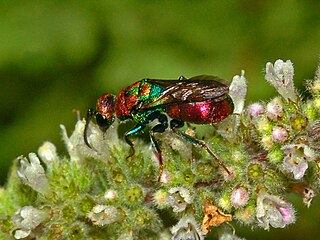
Hedychrum is a large genus of cuckoo wasps. With roughly 150 species, it is the second largest genus in the family; most species are from the Palaearctic, but they can be found in the Oriental, Afrotropical, Nearctic, and Neotropical regions. Their hosts are typically from the subfamily Philanthinae.
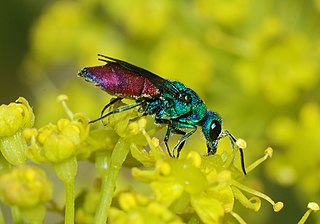
Chrysura is a genus of cuckoo wasps which parasitize megachilid bees. There are 117 species in Chrysura, all but 11 of which are found in the Palaearctic, making it the third largest genus in the family. The genus was described by Dahlbom in 1845, and the type species for the genus is Chrysura austriaca.

Chrysis ignita is a species of cuckoo wasp. It is one of a group of species which are difficult to separate and which may be referred to as ruby-tailed wasps.

Chrysidea pumila is a species of cuckoo wasps belonging to the subfamily Chrysidinae. Some authors consider this species as a synonym of Trichrysis pumilionis Linsenmaier, 1987.

Holopyga is a genus of cuckoo wasps.
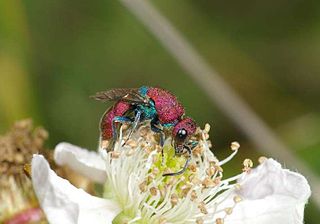
Chrysura cuprea is a species of cuckoo wasps.

Chrysis viridula is a Western Palearctic species of cuckoo wasp, first described by Carl Linnaeus in 1761. Chrysis viridula is included in the genus Chrysis, and the family Chrysididae. It is a parasitoid of a number of species of eumenid wasp, mainly those in the genus Odynerus.

Chrysura simplex is a species of cuckoo wasps, insects in the family Chrysididae.
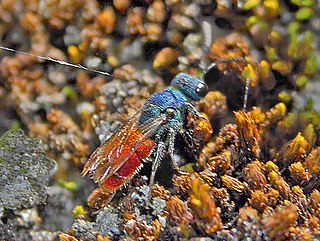
Chrysis ruddii, the ruby-tailed wasp, is a species of cuckoo wasps, an insects in the family Chrysididae.

Trichrysis cyanea is a species of cuckoo wasps, insects in the family Chrysididae.

Chrysis angustula is a species of cuckoo wasps, insects in the family Chrysididae.

Omalus aeneus is a species of cuckoo wasps belonging to the family Chrysididae.
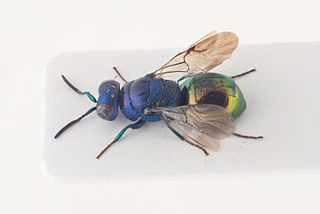
Omalus biaccinctus is a species of cuckoo wasps belonging to the family Chrysididae.

Chrysis fulgida, the ruby-tailed wasp, is a species of cuckoo wasp in the family Chrysididae.

Chrysura hirsuta, also known as the Northern Osmia ruby-tailed wasp, is a species of parasitic cuckoo wasp within the family Chrysididae.




















